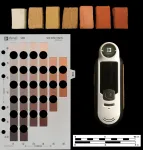(Press-News.org) GAINESVILLE, Fla. --- A ruler and scale can tell archaeologists the size and weight of a fragment of pottery - but identifying its precise color can depend on individual perception. So, when a handheld color-matching gadget came on the market, scientists hoped it offered a consistent way of determining color, free of human bias.
But a new study by archaeologists at the Florida Museum of Natural History found that the tool, known as the X-Rite Capsure, often misread colors readily distinguished by the human eye.
When tested against a book of color chips, the machine failed to produce correct color scores in 37.5% of cases, even though its software system included the same set of chips. In an analysis of fired clay bricks, the Capsure matched archaeologists' color scores only 35% of the time, dropping to about 5% matching scores when reading sediment colors in the field. Researchers also found the machine was prone to reading color chips as more yellow than they were and sediment and clay as too red.
"I think that we were surprised by how much we disagreed with the instrument. We had the expectation that it would kind of act as the moderator and resolve conflicts," said Lindsay Bloch, collection manager of the Florida Museum's Ceramic Technology Lab and lead study author. "Instead, the device would often have an entirely different answer that we all agreed was wrong."
Identifying subtle differences in color can help archaeologists compare the composition of soil and the origins of artifacts, such as pottery and beads, to understand how people lived and interacted in the past. Color can also reveal whether materials have been exposed to fire, indicating how communities used surrounding natural resources.
Today, the Munsell color system, created by Albert Munsell in 1905 and later adopted by the U.S. Department of Agriculture for soil research, is the archaeological standard for identifying colors. Researchers use a binder of 436 unique color chips to determine a Munsell color score for artifacts, sediment and objects such as bones, shell and rocks. These scores enable archaeologists around the world to compare colors across sites and time periods. But the process of assigning scores can vary based on lighting conditions, the quality of a sample and the perspective of the researcher.
This study is the first to test and record the accuracy of the X-Rite Capsure, a device made by the same company that owns the color authority Pantone. Although marketed to archaeologists, the device was originally designed for interior designers and cosmetologists, not research, Bloch said.
"I think the main takeaway was just sort of surprise that it's something that is marketed for our field, specifically for archaeologists, but hasn't been made for us and the kind of data we need to collect," she added. "When you read the manual, it says you should always verify that the color the machine tells you looks right with your eyes, which seems to negate the use of the instrument."
In an experiment designed with the help of University of Florida undergraduate researchers Claudette Lopez and Emily Kracht, the team tested the Capsure's readings of the three elements of Munsell's system: a color's general family, or hue; intensity, also known as chroma; and lightness, also called value.
The team first tested the Capsure on all 436 Munsell soil color chips, rating its reading as correct if it matched the exact score on a chip three out of five times. It correctly scored 274 chips. Of its errant readings, about 75% were misidentifications of hue. The Capsure was consistent, though often wrong, producing the same reading five times for 89% of the chips.
To determine how well the machine performed in a typical laboratory setting, the team tested its color readings of 140 pottery briquettes that had been assigned Munsell scores by Lopez. The Capsure matched the archaeologist's scores in 35% of cases, again tending to misread hue. It proved consistent in this second test as well, yielding the same score across all trials of more than 70% of the briquettes.
In the most challenging of color-identification conditions - outdoors, where lighting and texture can vary - the machine only matched archaeologists' scores of sediment samples about 5% of the time, often rating a shade darker or lighter. For one sample, the Capsure reported colors from five different families, even though archaeologists agreed the sediment was a single hue. Bloch said the discrepancy was likely due to moisture, sand and shells, which don't usually interfere with human observations.
Unlike some other methods of identifying color, the Capsure is a remote control-sized device that can provide a reading in seconds. Bloch said the tool's simple design and accessibility lend it to other scientific applications, but that the team's results point to a need for further scrutiny of how archaeologists record color.
"This new tool has really forced us to see that color is subjective and that, even with a supposedly objective instrument, it may be much more complicated than we've been led to believe," she said. "We need to pay really close attention and record how we're describing color in order to make good data. Ultimately, if we're putting bad color data in, we're going to get bad data out."
Bloch said she would give the Capsure three out of five stars for being easy to use and offering helpful ways to store data.
"The ding is for the quality of data because it's still kind of unknown. At this point, I think that our team would say the subjective eye is better."
INFORMATION:
Co-authors of the study are Lopez and Kracht, Jacob Hosen of Purdue University and the Florida Museum's Michelle LeFebvre, Rachel Woodcock and William Keegan.
Funding for the research came from the University of Florida Caribbean Archaeology Fund.
Individually, California blackworms live an unremarkable life eating microorganisms in ponds and serving as tropical fish food for aquarium enthusiasts. But together, tens, hundreds, or thousands of the centimeter-long creatures can collaborate to form a "worm blob," a shape-shifting living liquid that collectively protects its members from drying out and helps them escape threats such as excessive heat.
While other organisms form collective flocks, schools, or swarms for such purposes as mating, predation, and protection, the Lumbriculus variegatus worms are unusual in their ability to braid themselves together to accomplish tasks that unconnected individuals cannot. A new study reported by researchers at ...
HOUSTON - (Feb. 9, 2021) - Finding a needle in a haystack is hard enough. But try finding a specific molecule on the needle.
Rice University researchers have achieved something of the sort with a new genome editing tool that targets the supporting players in a cell's nucleus that package DNA and aid gene expression. Their work opens the door to new therapies for cancer and other diseases.
Rice bioengineer Isaac Hilton, postdoctoral researcher and lead author Jing Li and their colleagues programmed a modified CRISPR/Cas9 complex to target specific histones, ubiquitous epigenetic proteins that keep DNA in order, ...
RIVERSIDE, Calif. -- A team led by astronomers at the University of California, Riverside, has found that some dwarf galaxies may today appear to be dark-matter free even though they formed as galaxies dominated by dark matter in the past.
Galaxies that appear to have little to no dark matter -- nonluminous material thought to constitute 85% of matter in the universe -- complicate astronomers' understanding of the universe's dark matter content. Such galaxies, which have recently been found in observations, challenge a cosmological model used by astronomers called Lambda Cold Dark Matter, or LCDM, where all galaxies are surrounded by a massive and extended dark matter halo.
Dark-matter-free galaxies are not well understood in the astronomical community. ...
UCLA RESEARCH ALERT
FINDINGS
In a study of mice, researchers at the UCLA Jonsson Comprehensive Cancer Center have identified a new approach that combines an anti-psychotic drug, a statin used to lower high cholesterol levels, and radiation to improve the overall survival in mice with glioblastoma. Glioblastoma is one of the deadliest and most difficult-to-treat brain tumors. Researchers found the triple combination extended the median survival 4-fold compared to radiation alone.
BACKGROUND
Radiation therapy is part of the standard-of-care treatment regimen for glioblastoma, often helping prolong the survival of patients. However, survival times have not improved significantly over the past two decades and attempts to improve the efficacy ...
The construction of a major railway through Kenya will have long-term environmental impacts on the area, suggesting more work needs to be done to limit the damage on future infrastructure projects, a major study reveals.
The biggest impact of the Standard Gauge Railway (SGR), which runs from Mombasa to Nairobi, was pollution and contamination of soil, water and air, as well as disruption of natural processes.
The research, led by the University of York and part of the Development Corridors Partnership project, also showed environmental issues as a result of breaking up large areas of habitat into smaller, more isolated patches, that may not be able to support long-term natural processes.
The SGR project was given the go-ahead following the completion ...
A multi-institutional team became the first to generate accurate results from materials science simulations on a quantum computer that can be verified with neutron scattering experiments and other practical techniques.
Researchers from the Department of Energy's Oak Ridge National Laboratory; the University of Tennessee, Knoxville; Purdue University and D-Wave Systems harnessed the power of quantum annealing, a form of quantum computing, by embedding an existing model into a quantum computer.
Characterizing materials has long been a hallmark of classical supercomputers, which encode information using a binary system of bits that are each assigned a value of either 0 or 1. But quantum computers -- in this case, D-Wave's 2000Q - rely on qubits, which can be valued at ...
Wolves are arguably the most well-studied large predators in the world, yet new research shows there is still a lot to learn about their hunting tactics. Typically, wolves hunt large mammals like moose, deer, and bison in packs by outrunning, outlasting, and exhausting their prey. However, throughout the dense boreal forests in North America and Eurasia, during the summer wolves often hunt beavers by themselves.
But how does a wolf catch a semi-aquatic prey that spends little time on land and never ventures far from the safety of its pond? Turns out with patience, and a lot of waiting.
In a new paper published in the journal Behavioral Ecology, researchers from the University of Minnesota and the Voyageurs Wolf Project--which ...
CHICAGO: Elderly patients (70 years and over) with locally advanced esophageal (E) and esophagogastric junction (EGJ) cancer (located in the stomach and esophagus) should be considered for optimal therapy that has the potential to cure. This therapy regimen includes initial chemoradiotherapy (NACR) and surgical resection, an operation that removes the cancerous part of the organ.
According to researchers, this recommended therapy is often not offered to elderly patients out of concern that they will not tolerate such an intensive treatment regimen. In a new study, they found that older patients who received the therapy had outcomes comparable with those of younger patients (under 70 years old). The single-institution study from the Ochsner Clinic Foundation and The University of ...
PROVIDENCE, R.I. [Brown University] -- A new study finds that providing people who have recently given birth access to long-acting reversible methods of contraception, such as intrauterine devices and contraceptive implants, could help prevent them from unintentionally falling pregnant in the following months.
The study -- which analyzed the effects of a 2012 Medicaid policy implemented in South Carolina -- found that expanded access to particular forms of birth control were especially helpful in preventing unintended pregnancies among adolescents who had just given birth, giving them more control over their own futures.
"The ...
GRAND RAPIDS, Mich. (Feb. 9, 2021) -- Scientists have devised a new approach for detecting and potentially heading off the effects of two rare pediatric diseases before birth.
The study, performed in mouse models of the diseases and published today in Cell Reports, represents an important step toward much-needed early interventions for Beckwith-Wiedemann syndrome and Silver-Russell syndrome.
Both diseases result in growth-related symptoms in children and often lead to additional problems later in life, such as increased cancer risk from Beckwith-Wiedemann syndrome ...






